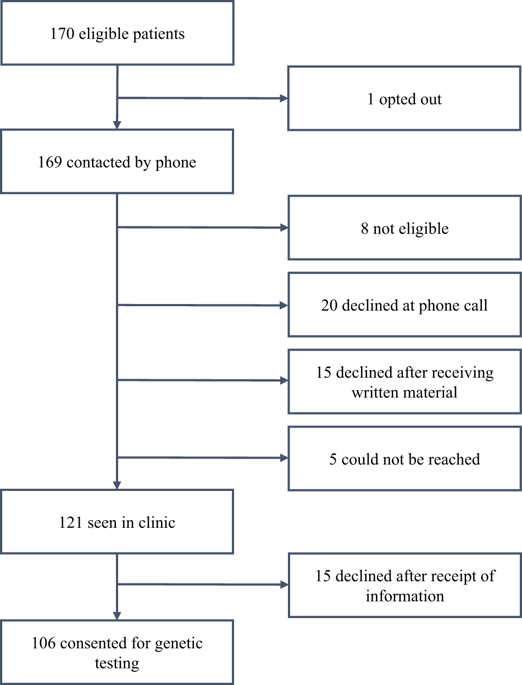当前位置:
X-MOL 学术
›
Eur. J. Hum. Genet.
›
论文详情
Our official English website, www.x-mol.net, welcomes your
feedback! (Note: you will need to create a separate account there.)
Exome sequencing in infants with congenital hearing impairment: a population-based cohort study.
European Journal of Human Genetics ( IF 3.7 ) Pub Date : 2019-12-12 , DOI: 10.1038/s41431-019-0553-8 Lilian Downie 1, 2, 3, 4 , Jane Halliday 2, 4 , Rachel Burt 2, 4 , Sebastian Lunke 1, 2, 4 , Elly Lynch 1, 2, 5 , Melissa Martyn 2, 4, 5 , Zeffie Poulakis 2, 3, 4 , Clara Gaff 4, 5 , Valerie Sung 2, 3, 4 , Melissa Wake 2, 4 , Matthew F Hunter 6, 7 , Kerryn Saunders 6, 7 , Elizabeth Rose 2, 3, 4 , Sharon Lewis 2, 4 , Anna Jarmolowicz 1, 2 , Dean Phelan 1, 2 , Heidi L Rehm 8 , , David J Amor 1, 2, 3, 4
European Journal of Human Genetics ( IF 3.7 ) Pub Date : 2019-12-12 , DOI: 10.1038/s41431-019-0553-8 Lilian Downie 1, 2, 3, 4 , Jane Halliday 2, 4 , Rachel Burt 2, 4 , Sebastian Lunke 1, 2, 4 , Elly Lynch 1, 2, 5 , Melissa Martyn 2, 4, 5 , Zeffie Poulakis 2, 3, 4 , Clara Gaff 4, 5 , Valerie Sung 2, 3, 4 , Melissa Wake 2, 4 , Matthew F Hunter 6, 7 , Kerryn Saunders 6, 7 , Elizabeth Rose 2, 3, 4 , Sharon Lewis 2, 4 , Anna Jarmolowicz 1, 2 , Dean Phelan 1, 2 , Heidi L Rehm 8 , , David J Amor 1, 2, 3, 4
Affiliation

|
Congenital hearing impairment (HI) is the most common sensory impairment and can be isolated or part of a syndrome. Diagnosis through newborn hearing screening and management through early intervention, hearing aids and cochlear implantation is well established in the Australian setting; however understanding the genetic basis of congenital HI has been missing. This population-derived cohort comprised infants with moderate-profound bilateral HI born in the 2016-2017 calendar years, detected through newborn hearing screening. Participants were recruited through an integrated paediatric, otolaryngology and genetics HI clinic and offered whole exome sequencing (WES) on a HiSeq4000 or NextSeq500 (Illumina) platform with a targeted average sequencing depth of 100x and chromosome microarray on the Illumina Infinium core exome-24v1.2 platform. Of those approached, 68% (106/156) consented to participate. The rate of genetic diagnosis was 56% (59/106), significantly higher than standard of care (GJB2/6 sequencing only), 21% (22/106). There were clinical implications for the 106 participants: 36% required no further screening, 9% had tailored screening initiated, 2% were offered treatment and 4% had informed care for a complex neurodevelopmental syndrome. WES in this cohort demonstrates the range of diagnoses associated with congenital HI and confirms the genetic heterogeneity of congenital HI. The high diagnostic yield and clinical implications emphasises the need for genomic sequencing to become standard of care.
中文翻译:

先天性听力障碍婴儿的外显子组测序:一项基于人群的队列研究。
先天性听力障碍(HI)是最常见的感觉障碍,可以孤立或为综合症的一部分。在澳大利亚,通过新生儿听力筛查进行诊断,并通过早期干预,助听器和人工耳蜗植入进行诊断。然而,缺乏对先天性HI的遗传基础的了解。通过新生儿听力筛查发现,该人群来源的队列包括2016-2017历年出生的中度双侧HI婴儿。通过综合的儿科,耳鼻喉科和遗传学HI诊所招募参与者,并在HiSeq4000或NextSeq500(Illumina)平台上提供全外显子组测序(WES),目标平均测序深度为100x,并在Illumina Infinium核心exome-24v1上提供染色体微阵列。 2平台。在接近的人中,有68%(106/156)同意参加。遗传诊断率为56%(59/106),显着高于护理标准(仅GJB2 / 6测序)和21%(22/106)。这对106名参与者有临床意义:36%的人不需要进一步筛查,9%的患者需要进行有针对性的筛查,2%的患者接受了治疗,4%的患者接受了复杂神经发育综合征的知情护理。此队列中的WES证明了与先天性HI相关的诊断范围,并证实了先天性HI的遗传异质性。高诊断率和临床意义强调了基因组测序成为护理标准的必要性。21%(22/106)。这对106名参与者有临床意义:36%的人不需要进一步筛查,9%的患者需要进行有针对性的筛查,2%的患者接受了治疗,4%的患者接受了复杂神经发育综合征的知情护理。此队列中的WES证明了与先天性HI相关的诊断范围,并证实了先天性HI的遗传异质性。高诊断率和临床意义强调了基因组测序成为护理标准的必要性。21%(22/106)。这对106名参与者有临床意义:36%的人无需进一步筛查,9%的患者开始了特制筛查,2%的患者接受了治疗,4%的患者接受了复杂的神经发育综合征的知情护理。此队列中的WES证明了与先天性HI相关的诊断范围,并证实了先天性HI的遗传异质性。高诊断率和临床意义强调了基因组测序成为护理标准的必要性。此队列中的WES证明了与先天性HI相关的诊断范围,并证实了先天性HI的遗传异质性。高诊断率和临床意义强调了基因组测序成为护理标准的必要性。此队列中的WES证明了与先天性HI相关的诊断范围,并证实了先天性HI的遗传异质性。高诊断率和临床意义强调了基因组测序成为护理标准的必要性。
更新日期:2019-12-13
中文翻译:

先天性听力障碍婴儿的外显子组测序:一项基于人群的队列研究。
先天性听力障碍(HI)是最常见的感觉障碍,可以孤立或为综合症的一部分。在澳大利亚,通过新生儿听力筛查进行诊断,并通过早期干预,助听器和人工耳蜗植入进行诊断。然而,缺乏对先天性HI的遗传基础的了解。通过新生儿听力筛查发现,该人群来源的队列包括2016-2017历年出生的中度双侧HI婴儿。通过综合的儿科,耳鼻喉科和遗传学HI诊所招募参与者,并在HiSeq4000或NextSeq500(Illumina)平台上提供全外显子组测序(WES),目标平均测序深度为100x,并在Illumina Infinium核心exome-24v1上提供染色体微阵列。 2平台。在接近的人中,有68%(106/156)同意参加。遗传诊断率为56%(59/106),显着高于护理标准(仅GJB2 / 6测序)和21%(22/106)。这对106名参与者有临床意义:36%的人不需要进一步筛查,9%的患者需要进行有针对性的筛查,2%的患者接受了治疗,4%的患者接受了复杂神经发育综合征的知情护理。此队列中的WES证明了与先天性HI相关的诊断范围,并证实了先天性HI的遗传异质性。高诊断率和临床意义强调了基因组测序成为护理标准的必要性。21%(22/106)。这对106名参与者有临床意义:36%的人不需要进一步筛查,9%的患者需要进行有针对性的筛查,2%的患者接受了治疗,4%的患者接受了复杂神经发育综合征的知情护理。此队列中的WES证明了与先天性HI相关的诊断范围,并证实了先天性HI的遗传异质性。高诊断率和临床意义强调了基因组测序成为护理标准的必要性。21%(22/106)。这对106名参与者有临床意义:36%的人无需进一步筛查,9%的患者开始了特制筛查,2%的患者接受了治疗,4%的患者接受了复杂的神经发育综合征的知情护理。此队列中的WES证明了与先天性HI相关的诊断范围,并证实了先天性HI的遗传异质性。高诊断率和临床意义强调了基因组测序成为护理标准的必要性。此队列中的WES证明了与先天性HI相关的诊断范围,并证实了先天性HI的遗传异质性。高诊断率和临床意义强调了基因组测序成为护理标准的必要性。此队列中的WES证明了与先天性HI相关的诊断范围,并证实了先天性HI的遗传异质性。高诊断率和临床意义强调了基因组测序成为护理标准的必要性。











































 京公网安备 11010802027423号
京公网安备 11010802027423号